K.M. Alexander's Blog, page 57
March 30, 2016
A Norwescon 39 Debriefing
This past weekend I attended Norwescon 39 in SeaTac, Washington. This was my second year attending and like last year I had an outstanding time. As readers of my blog know with all my convention appearances, I like to do a debriefing wherein I recap the events, share photos, and talk about what I experienced during the con. (Check out my debriefing from last year.)
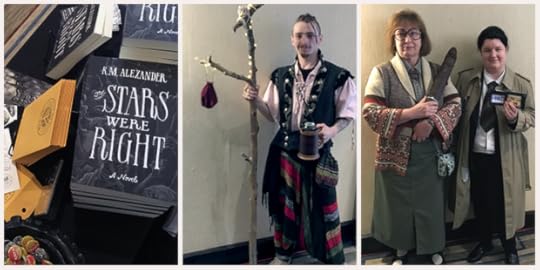
It was a wild weekend. I ran my table, sold a bunch of books, sat on six panels, and did a reading. Somewhere in there, I tried to get some sleep. Thankfully, unlike last year, I was not alone for the fours days; this time, I had assistance. My friend and fellow author, Steve Tontounghi came out on Friday and Saturday helped me out at my table and talked to people about his forthcoming novel, Join. And my wife Kari-Lise stepped up and pitched in Thursday, Saturday, and Sunday. It was fun hanging out with them both. With their help, there weren’t any eleven-hours-on-my-feet days for me to deal with like last year. That alone made my time significantly more enjoyable.
Okay, let’s get to those highlights:
Books, Readings, Swag, and More

Once again, I sold a ton of books. Many were to new readers who seemed excited about stories set in a post-Lovecraftian world, and many were to my current readers who loved my books and wanted more. It was wonderful hearing directly from so many people and very encouraging.
I love when folks stop by and tell me how much they love my covers. I take a lot of time and effort to make sure they are something you’ll be proud of having on your bookshelf and knowing you notice means a lot.
This was the first year I handed out badge ribbons . I brought along three: Roader, Shambler, and Caravan Master (the rare one). I made a bet with my buddy Ace that he wouldn’t be able to collect all three. (I only allowed people to draw once.) He won. *grumble grumble* It was fun, and I think it might become a thing for everyone. Still trying to plot out how to make that work.
So many people came to my reading! As many of you know, I had the readers of this very blog choose what I read . As decided by the voters with 56.25% of the votes, I read the prologue from Red Litten World. People enjoyed it in all its grisly details. The next day quite a few attendees came to my table and bought a book because they liked what they heard. That made my con right there.
Friends & Fellow Authors
It was great meeting so many amazing fellow authors for the first time: Logan Masterson , Elliot Kay , Jason Vanhee , Nathan Crowder , Lisa Bolekaja , Matt Youngmark , and Peter Orullian . (If I missed you, I am sorry! It’s not intentional.)
I loved Seeing old friends from last year. Fellow writers Lee French , Robert Hazelton, and Jennifer Brozek were there. As was Rob’s wife Erica, and my buddy Ace. It was cool to see folks again; it felt like it had only been a few days since we hung out as opposed to the whole year.
I also recognized a lot of people, which is great, it goes a long way to making the Norwescon community feel more tight knit.
Oh, The Panels!
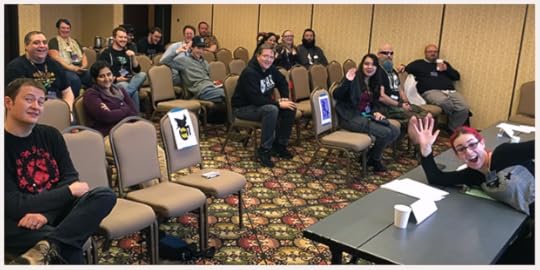
The Sci-Fi/Fantasy Battle Royale was easily the best panel I was on, I know I’m not alone in thinking this, here’s proof. It was hilarious, snarky, and a total blast. Big thanks to Matt Youngmark for putting it together and keeping things organized. The format was a bracket-style who-would-win-in-a-fight “discussion” in the end it came down to Rey from The Force Awakens and Marvel’s Captain Marvel/Carol Danvers. I was on team Rey in the final matchup, and sadly by popular vote, she lost. Maybe next year. #ReyWasRobbed. Agree? Feel different? Leave a comment and let me know why!
The horror track was really well put together. I was lucky enough to sit in on four different panels and had some incredible conversations about location, inspiration, and how horror is often a reflection of the time in which it is written. The first panel, expertly moderated by Logan Masterson, was about horror’s fantasy roots and stood out as the best of them, a lot of intelligent discussion.
The last panel I attended was ‘Level Up Your Self-Publishing Skills’ moderated by Elliot Kay. It was packed, and there was a lot of great questions from those in attendance. I wish it could have been more than an hour. There’s so much more all of us authors on that panel could have said, I wish we had more time. If you ever have a question about self/indie publishing you are always more than welcome to email me at hello@kmalexander.com . I’m happy to offer tips or advice where and when I can. As always, the best advice I can give is this: keep at it, write what you love, and never give up.
Cosplay & Norwesconners
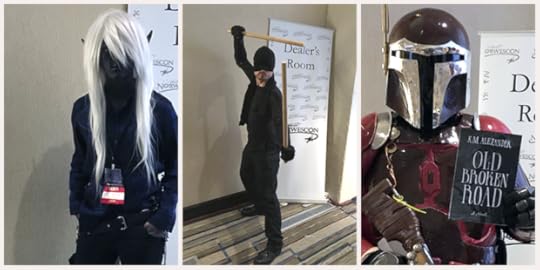
Have I mentioned the incredible cosplay, yet? Well, as always it was fantastic, people put in a lot of time and effort, and it showed.
Tiny Rey was easily the most adorable cosplayer I saw. Let me go on record saying that I am so stoked to see another female character in Star Wars that young girls can emulate. Mad props to the writers for making that decision. It was needed.
Rorschach and I recreated out selfie photo from last year. Here was the photo from Norwescon 39 and the photo from last year, Norwescon 38 . Kari-Lise pointed out that they are mirror images of each other. Not intentional and kind of funny.
I got a quest from an NPC . It was hilarious. That card is now pinned to my cork board above my desk. Someday I’ll find you drunken ghost.
I mentioned this last year, but it’s worth mentioning again. It’s remarkable to see the diversity, openness, and acceptance between Norwesconners. The world outside of a convention can be mean. It’s nice to see a place where everyone is super considerate and goes out of their way to be encouraging and welcoming. Norwescon is unique like that.
Little Incidental Highlights
The Philip K. Dick Awards , I had a panel and was running a table, so I didn’t get to attend. But congratulations to Ramez Naam for his novel Apex winning the award. Also, congratulations to the special citation winner, Marguerite Reed for her novel Archangel .
Sunday’s cello accompaniment was lovely. Is this a regular thing? I remember there was music last year as well.
The green room staff, wonderful people there. They made the room a nice respite before and after panels.
The Norwescon staff were all really great. Thanks to everyone for making the event such a success. It’s a lot of hard work. Next time you see a volunteer, thank them.
It was a packed weekend, but so worth it. I’m already missing the whole buzz of the convention halls and the enthusiasm from my fellow attendees. There were a few times I wanted to get into the nitty-gritty details of writing horror and time just didn’t allow it. It would have been great to have sat in on a panel that was specific to cosmic horror/weird fiction and Lovecraftian mythos, but that might be too narrow for a general sci-fi/fantasy convention like Norwescon.
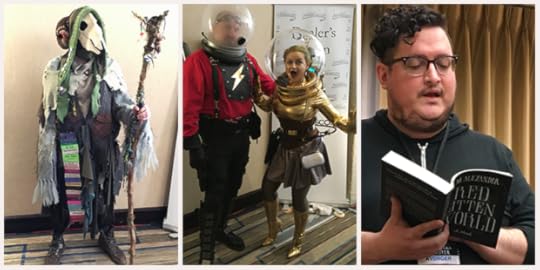
Sunday night Kari-Lise and I came home exhausted but feeling accomplished. Monday morning, I rolled right from convention mode back into work mode. No rest for the wicked. I’ll see you again Norwescon, until then, it’s back to writing. Time is wasting, and I have many more stories to tell.
Filed under: Con Reports Tagged: books, convention, cosplay, Horror, join, kari-lise alexander, norwescon, nwc39, panels, Red Litten World, self-publishing, steve tontounghi








March 28, 2016
Don’t Bend
“Don’t bend; don’t water it down; don’t try to make it logical; don’t edit your own soul according to the fashion. Rather, follow your most intense obsessions mercilessly.”
So, interesting aside. This quote is oddly often misattributed to Franz Kafka when in fact it comes from an introduction written by Anne Rice about a collection of Kafka short stories in 1995. The Quote Investigator had a great little post about it. Check it out here →
Filed under: Quotes Tagged: anne rice, creativity, franz kafka, Inspiration, Writing 







March 21, 2016
Come See Me at Norwescon 39
You are all probably aware by now that starting this Thursday I will be attending Norwescon 39 in SeaTac Washington, and it’s going to be a busy four days. Not only will I be running a table on Writer’s Row, but I will also be on quite a few panels, and I’m doing a reading Saturday night. Come on by and say hello!
You can click here to view my full schedule of panels. If you’re a Guidebook user (and you should be, it’s a handy app), you can find me on there as well. When I’m not on a panel, look for me at table 43. I’ll be beneath a big Bell Forging Cycle banner. You can also click the image below to see where I will be hanging out most of the time.
On Friday the 25th, my good friend and fellow author Steve Tontounghi will be helping me out at my table. His incredible debut novel, Join, comes out in a little under a month (April 19th) make sure to ask him about it. He has some cool custom badge ribbons and a few advanced review copies of Join to giveaway. So keep and eye out for him!
My table is going to be full! Like last year I will be bringing copies of my books and all three The Stars Were Right, Old Broken Road, and Red Litten World can be purchased at a special convention price. Plus, I’ll also have Bell Caravans patches for sale as well. As with previous cons, there will be plenty of free swag: stickers, bookmarks, buttons, and my super cool badge ribbons.
Finally, until Wednesday, you can still vote for which book I’ll read from Saturday night. Right now Red Litten World is ahead, but The Stars Were Right is close right behind it. Nothing like listening to me read some Lovecraftian urban fantasy right before your evening starts. If you haven’t already, click here and vote.
Norwescon 39 starts in 4 days! Looking forward to seeing everyone there.
Filed under: Upcoming Appearances Tagged: bell caravans patch, conventions, join, norwescon 39, Old Broken Road, panels, reading, Red Litten World, steve tontounghi, The Stars Were Right, writer's row








March 16, 2016
I’m Doing a Reading – Help Me Choose Which Book
Norwescon 39 is just over a week away, and on Saturday night, the 26th of March I’ll be doing a reading! (9:00 PM in Cascade 1, Come see me.) Hooray! In the past I’ve read the prologue from The Stars Were Right, I mean, it’s the beginning, right? It’s a good place as any to introduce people to the world of The Bell Forging Cycle. But I was thinking, Red Litten World has been out now for five months now, and while each book builds off of each other they have been written to be standalone novels, the books can be read in any order. So I don’t have to be worried about spoiling anything. That has tempted me to read the Red Litten World prologue instead.
Instead of hemming and hawing over the decision myself. I figured why not ask you, my community of amazing and loyal readers! Which book do you think I should read? Should it be the introduction with the anur spectacles dealer from The Stars Were Right, or should it be the prologue with the creepy evangelist from Red Litten World? Use the poll below and vote. Voting will continue for a week and end next Wednesday, the 23rd. Whatever book wins will be the book I read at Norwescon!
You can see my full Norwescon 39 schedule over here. Make sure you stop by my table on Writer’s Row and say hello. We can talk about Lovecraft, horror in general, sci-fi, fantasy, the world of the Territories, whatever! I’ll have all three books available for purchase (at the discounted convention price.) You can pick up some free swag and make sure to ask me about how you can get one of my badge ribbons. There is a lot of stuff going on and I can’t wait to hang out with everyone. So vote and I’ll see you at the convention!
Filed under: The Bell Forging Cycle, Upcoming Appearances Tagged: box of choosing, conventions, norwescon, Old Broken Road, poll, Red Litten World, sea tac, Swag, The Stars Were Right, writer's row








March 8, 2016
Thrums… Thrums in the Deep
It’s been a while since I have offered up something new on the Free Stuff Page. So over the weekend, I cranked out a new desktop background for the fans and readers of the Bell Forging Cycle featuring a quote from my latest novel in the series: Red Litten World.
Strange words are oft-uttered beneath a shattered sun. This ominous bit of prophecy, spoken by one of the characters within the book, hints at sinister developments. Unlike other backgrounds, I was trying to play this one a bit more subtle, so I hope everyone likes it! Download this background from any of the links below, or click through to the Free Stuff page and check out the other free offerings.
1280×800 • 1366×768 • 1440×900 • 1680×1050
1920×1080 • 2560×1440 • iPad Air/Mini • iPad Pro
iPhone 5 • iPhone 6 • iPhone 6+
Love my books? Hate them? Leave an honest review! (Consider: Amazon or Goodreads) As I’ve said before, I can blog, tweet, and shout from the rooftops, but it’s you, my readers, that make all the difference when it comes to spreading the word.
Filed under: Swag, The Bell Forging Cycle Tagged: ashton, background, free stuff, prophecy, quote, Red Litten World








February 29, 2016
Norwescon 39 Badge Ribbons
Norwescon 39 is happening in only twenty-five days. This will be my second year attending, and if you’re in the Seattle area March 24-27th, you should come! You can preregister here, only $70 for the four days. It’s a great group of amazing people, and there is a ton to see and do, and plenty of places for you to participate.
If you follow me on Instagram, yesterday I posted a sneak peek of some of the new swag I am bringing to the convention: badge ribbons. Last year I discovered everyone’s affinity for the little things, and I can totally see the draw. They’re fun. Badge ribbons are little pieces of flair you attach to the bottom of your convention badge. They spell out all manner of things. Some are funny, some are silly, some go the way of nostalgia, some are descriptive titles, and some are informative. Throughout the convention, attendees collect these ribbons and attach them to one another, and the length of their ribbon chain grows and grows.
 Thanks to
Newt!
(Left) and
Loree Parker
(Right) for letting me use their photos from Norwescon 38
Thanks to
Newt!
(Left) and
Loree Parker
(Right) for letting me use their photos from Norwescon 38Loree Parker’s badge was so tall I had to do some fancy photoshop work just to get a portion of her ribbons into the picture, check out the whole thing here. My own badge was a pittance in comparison, only three ribbons (such is the case when you’re trapped at a table. C’est la vie!) Since I am returning this year and a lot more active, I wanted to participate. So, I began brainstorming some ideas for ribbons. What could I bring? Obviously, straight forward advertising on these ribbons is dumb, but I still wanted to tie my ribbons into my books and the Lovecraft mythos in general. I think I settled on a good solution. I am happy to say I will be bringing not one but three ribbons to Norwescon 39. Here they are:
Caravan Master – Silver on Black

Roader – White on Black

Shambler – White on Black

Like most of my swag, these ribbons are free, but there’s a catch. I’m turning this into a game. Of these three ribbons, you’re only going to get one. To get your hands on these beauties, you’ll need to track me down when I’m at my table on Writers Row (my full schedule is posted here), and you have to ask me about the ribbons. I will then produce THE BOX OF CHOOSING™, and you’ll get to draw a ribbon from the box. Only one ribbon is allowed per attendee, and whatever you draw is your ribbon. We’ll do this until I run out. The Roader and Shambler ribbons are plentiful, but there us only going to be about twenty-five of the rare and elusive Caravan Master ribbons. So, if you see someone lucky enough to get one, give them a sharp salute.
See you in twenty-five days.
Filed under: Swag, Upcoming Appearances Tagged: badge, Bell Caravans, box of choosing, caravan master, norwescon, ribbons, Roader, seatac, seattle, shambler








February 25, 2016
Right in the Feelies
Last weekend, I finished reading Aldous Huxley famous dystopian novel, Brave New World. It was as good as I remembered and was a pleasure to re-read it during in my “Year of Classics.” But, this isn’t a post about classic dystopian novels; this is a post about storytelling and swag. Say whhhaaaat?
Allow me to explain how I got here. Within the novel, Huxley references “feelies” a sort-of hybrid source of entertainment where all senses are stimulated. While musing over this, I decided to do a little research. So I quickly googled the term and was surprised to learn that “feelie” was not only a Huxley invention (or a college-rock band from the eighties) it was also a slang term used in video games, particularly for a type of swag.
 Feelies included with Infocom’s The Hitchhiker’s Guide to the Galaxy
Feelies included with Infocom’s The Hitchhiker’s Guide to the GalaxyA feelie was the name given to the bonus content included with the boxed versions of video games in the late eighties and early nineties. Props, booklets, coins, runes, histories, cloth maps, and much more. These started with Infocom titles such as Zork, Planetfall, and the game version of The Hitchhiker’s Guide to the Galaxy.
Now, I realize that tchotchkes or swag is common across a lot of industries, and it’s something that crops up in the book industry as well. Go to any convention and you’ll come away with a haul, bookmarks, pens, bottle openers, tote bags, stickers, rubber bracelets, flyers. It’s popular and plentiful. I always have loads of swag at my table; I know many other authors do as well. Swag in its most rudimentary form is effectively an advertisement; feelies go a step further. They add a little something extra.
For example, Brandon Sanderson sells vials of allomantic metals similar to the ones allomancers imbibe in his Mistborn series. Hugh Howey once gave away Fallout Shelter passes (that doubled as USB drives) from his Wool series. In my own work, you can picture the dust-covered roaders of Bell Caravans wearing patches while on the trail. You get extra information from Wal’s notes scrawled on the Map of the Known Territories. There are hints at the history of the city in the illustrations on the Syringa postcard. These details are what separates a feelie from typical swag, a good feelie helps to expand its world as well as enhance it, they assist in making a fictional world feel real, they establish it as a place you can touch.
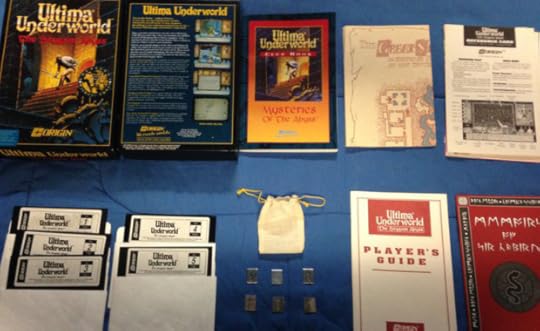 Feelies included with Origin’s Ultima Underworld: The Stygian Abyss
Feelies included with Origin’s Ultima Underworld: The Stygian AbyssI’ve been a big fan of this approach for a long time. To me, it’s another aspect of worldbuilding. Only instead of with writing you’re doing it with objects. The feelie reminds me of an alternate reality game, going beyond the page to establish a real-world presence for our fictional creations and increasing immersiveness. My books have always been seeded with a little something extra so why not carry that over to other outlets as well? I’ve scattered extra stuff throughout websites, in bookmarks, in posts on this blog, and on Tumblr. The Bell Caravan patches come with Caravan Employee Registration documentation, stamped by the Lovaine Caravan Authority, of course, and signed by Wal. (It’s also full of subtle little references.) I find this attention to details adds little extra for the reader who is willing to put in the time. There’s something very engaging when you introduce someone something tangible to connect them to a piece of fiction. To me, that is much more interesting than a tote bag or tee shirt with a book cover on it.
 Bell Caravans Patch with Included Caravan Employee Registration Form
Bell Caravans Patch with Included Caravan Employee Registration FormI’m cooking up a few new ideas as well, so there’s always more to come. I’ve been dreaming up feelies for my secret fantasy project, and I have some great ideas for the Coal Belly series, and The Bell Forging Cycle (as I mentioned, some of the latter is already out there, providing one is willing to put in the legwork to discover it.) I love making stuff associated with my world, and I love sharing those creations with readers. (I even give away swag packs for free.)
Now, how about you? What do you think of feelies? Do you prefer them to regular swag or do you find them silly? What has been your favorite feelie you’ve purchased or received? Are you a creator who has made something extra for your world? I’d love to see your creations, and I’m sure others would as well. Feel free to post a link in the comments and share them with all of us.
Filed under: Swag, Worldbuilding Tagged: aldous huxley, alternate reality game, Bookmarks, brave new world, feelies, Lovat, maps, patches, the bell forging cycle








February 22, 2016
Inspiration is for Amateurs
“The advice I like to give young artists, or really anybody who’ll listen to me, is not to wait around for inspiration. Inspiration is for amateurs; the rest of us just show up and get to work. If you wait around for the clouds to part and a bolt of lightning to strike you in the brain, you are not going to make an awful lot of work. All the best ideas come out of the process; they come out of the work itself. Things occur to you. If you’re sitting around trying to dream up a great art idea, you can sit there a long time before anything happens. But if you just get to work, something will occur to you and something else will occur to you and something else that you reject will push you in another direction. Inspiration is absolutely unnecessary and somehow deceptive. You feel like you need this great idea before you can get down to work, and I find that’s almost never the case.”
Kari-Lise shared this quote with me today; it was too good not to post here. It’s solid advice from an incredibly prolific artist. So, what are you going to do? Wait around for the lighting to strike or are you going to show up and get to work? In the end, it’s up to you.
Filed under: Quotes Tagged: advice, chuck close, ideas, Inspiration, process, work








January 26, 2016
My Norwescon 39 Schedule
Norwescon 39 is just around the corner (57 days!) and yesterday I received my tentative schedule! Last year I ran my table and had a blast. But this year, things are going to be a lot busier. As before, I’ll be back with another table among Writer’s Row, plus I’ll also be participating on panels, and I’ll be doing a reading on Saturday night. It’s going to be fun.
Full details are below. I tried to link to the blogs or twitter accounts for the panel’s moderators and my fellow panelists. I’m honored to be sitting next to such talented folks. I’m excited to hang out with everyone again. Listing all this out got me excited, I can’t wait.
THURSDAY, MARCH 24th
4:00 PM – 5:00 PM — Writer’s Row
Location: Writer’s Row
Details: Once again I’ll be headquartering myself at a table. Of course, I’ll bring along copies of all The Bell Forging Cycle books and, like last year, I’ll also have a bunch of free swag: stickers, buttons, and bookmarks galore. Stop on by, say hello. I’ll sign your books. We can talk cosmic horror, indie publishing, cover design, world building, weird fiction, Lovecraft, and pretty much whatever else you feel like.
5:00 PM – 6:00 PM — Horror’s Fantasy Roots
Location: Cascade 10
Moderator: Logan L. Masterson
Panelists: Jason Vanhee, Nathan Crowder, K. M. Alexander
Details: Join Logan L. Masterson, the other panelists, and myself as we discuss a time when the darkness was fought back with swords and sorcery as we explore the roots and the muddy line between fantasy and horror.
6:00 PM – 8:00 PM — Writer’s Row
Location: Writer’s Row
FRIDAY, MARCH 25th
10:00 AM – 12:00 PM — Writer’s Row
Location: Writers Row
12:00 PM – 1:00 PM — Horror Influences
Location: Cascade 9
Moderator: Nina Post
Panelists: Morgue Anne, Alex C. Renwick, Lisa Bolekaja, K. M. Alexander
Details: Join Nina Post as she talks with myself and the other panelists on who inspired us to write and create horror and on what scares us. Should be fun.
1:00 PM – 7:00 PM — Writer’s Row
Location: Writer’s Row
SATURDAY, MARCH 26th
10:00 AM – 6:00 PM — Writer’s Row
Location: Writer’s Row
6:00 PM – 7:00 PM — SF/Fantasy Battle Royale
Location: Cascade 9
Moderator: Matt Youngmark
Panelists: Erik Scott de Bie, Peter Orullian, K. M. Alexander
Details: Who would win in a fight? A fast-paced, bracket-style, breathtakingly unscientific showdown to determine this year’s Ultimate Fictional Champion. Ready…? Fight! This will be fun.
9:00 PM – 9:30 PM — Reading: K. M. Alexander
Location: Cascade 1
Moderator: K. M. Alexander
Details: Hey, look at this, I’m doing a reading! Before you hit up a room party or turn in for the evening why not come by and let me read you a creepy excerpt from one of my books. Which one… well, I’m not sure yet! (I might have a little poll to decide. Stay tuned.)
SUNDAY, MARCH 27th
10:00 AM – 11:00 AM — Horror As a Mirror
Location: Cascade 13
Moderator: Jeremy Zimmerman
Panelists: Jude-Marie Green, Kate Jonez, K. M. Alexander
Details: What does the horror genre tell us about the culture in which it was written? What does today’s horror tell us about modern society? And as a creator, how do we craft stories that have a greater impact by reflecting on things that resonate more deeply with our audiences? Join us for this thought-provoking panel.
11:00 AM – 1:00 PM — Writer’s Row
Location: Writer’s Row
1:00 PM – 2:00 PM — Location: Horror’s Unsung Character
Location: Cascade 10
Moderator: Laura Anne Gilman
Panelists: Lisa Bolekaja, Arinn Dembo, Logan L. Masterson, K. M. Alexander
Details: Where a story is set lends itself to the impact of that story. Whether you set your story in a crumbling castle, a small town in Maine, or a sleek office tower, how do writers craft a setting with staying power? Come for favorite examples and ways to build your own and play against expectations to greater effect.
2:00 PM – 3:00 PM — Writer’s Row
Location: Writer’s Row
3:00 PM – 4:00 PM — Level Up Your Self-Publishing Skills
Location: Cascade 12
Moderator: Elliott Kay
Panelists: Matt Youngmark, Ryan Macklin, K. M. Alexander
Details: Elliot Kay leads us in a discussion on self-publishing. How do you find a good editor or cover artist? What’s your pricing strategy? Does free work? What are the best keywords to use? How do you get reviews? We’ll discuss the best practices for putting out a professional product and the current strategies for finding success.
You can preregister for Norwescon 39 here and get passes to all four days for only $70. There’s also a lot of information at Norwescon.org including details on this year’s guests of honor, The Philip K. Dick Awards, Doubletree hotel information, and a lot more. Hopefully, I’ll see you there!
Filed under: Upcoming Appearances Tagged: conventions, norwescon, old broken road, panels, reading, red litten world, schedule, seatac, swag, the bell forging cycle, the stars were right, Washington








January 19, 2016
Fallout 4 and the Struggle of Consistent Worldbuilding
[!] Note: The following will contain minor spoilers for Bethesda Softworks’ Fallout 4. Consider yourself warned.
Last August I wrote an article exploring the masterful worldbuilding within George Miller’s post-apocalyptic thriller, Mad Max: Fury Road. [You can read it here.] It was easily my favorite film of 2015. There was a lot to love, both subtlety and nuance was scattered throughout the movie despite the fact that it was a two-hour action-packed car chase through a wasteland.
Well, this last fall the post-apocalyptic gods smiled on us twofold with the release of Fallout 4, Bethesda’s latest post-apocalyptic role-playing game. I’ve long been a fan of the series ever since I played the first Fallout on my PC as a kid. So I was excited. Heck, I even went out and bought a PS4 specifically to check it out. Now, before I start nitpicking, I need to preface that Fallout 4 is not a bad game. It’s a game I have been enjoying. It’s a game I would recommend. But, I think just like films, music, books, and art we can cast a critical eye at specific elements of a video game while still enjoying the game as a whole.
I was initially going to entitle this piece Fallout 4 and the Failures of Worldbuilding, but I retracted a bit. Mainly because that is both overly dramatic and clickbait garbage. Also, because in a lot of ways and in many places Fallout 4 has great worldbuilding, it’s just inconsistent. As a result, Fallout 4 continually pulls me out of the moment. Despite wanting you to engage with the world on a personal level, it doesn’t allow us to suspend our disbelief long enough to lose ourselves in its world. This makes it feel manufactured—it’s a post-apocalyptic Disneyland that is trying to be something more. A lot of that is because it falls short in one of the most important and fundamental principles of worldbuilding: it tells you one thing and then shows you something else.

First, some backstory: Fallout 4 takes place in an alternate reality two-hundred years after a thermonuclear war nearly wipes out humanity, your character—a survivor who awakened from a state of suspended animation in an underground vault—is thrust into an unforgiving and often violent world in the search for a kidnapped child. Now, missing child aside, remember that established time frame: two-hundred years. It’s important.
The discrepancy between that origin story and the world I was playing in first hit me ten minutes into the game. Up until then, I assumed maybe forty to fifty years had passed. The world certainly seemed like it was emerging from disaster, but when your Mr. Handy unit, Codsworth, introduced the timespan a lot of the following worldbuilding began to fall apart.

“A bit over 210 actually, sir. Give or take a little for the Earth’s rotation and some minor dings to the ole’ chronometer.”
When the player first emerges from the Vault, you come across the remnants of people who didn’t survive. Piles of skeletons lay outside the gate to the Vault, skeletons still wearing the clothes they died in, which didn’t make much sense. Here they are exposed to the elements, and a corpse’s dress is still recognizable as a dress? This is seen in other things as well. Many structures still stand despite little or no maintenance. Some still have power. Often these sorts of niggling details are explained away using Ragnarok-Proofing, the concept that objects in the world (buildings, robots, heck, even clothes) are just made better. So metal doesn’t rust in the same way, clothing doesn’t wear regularly, and power sources last much longer, etc. And, some of that exists, the nuclear cells powering the Commonwealth’s robots are a good example, and if that was all I’d accept it and move on. But that isn’t all, it cascades from there.

Two-hundred years is a long time. Two-hundred years ago my home city, Seattle, didn’t exist. My state, Washington, hadn’t even been conceived. Most of America lived on the East Coast and had no idea that in fifty years they were going to be in the midst of the Civil War. Yet, in Fallout 4’s world that two-hundred years doesn’t seem to have changed much of anything. If fact, it barely looks like any time has passed. Most of the world remains a burnt husk. Nothing “new” feels permanent. Most settlements are hastily constructed shantytowns, cobbled together from the remnants. What civilization does exist, happens to be a loose collection of scraped-together tribes with little or no regard for one another. Compare this to Mad Max: Fury Road, in the first ten minutes of the movie we saw societies, hierarchies, and civilization, we saw cities, small and large, and even trade routes.
We’ve been told it’s two-hundred years after a terrible event but we’re not shown that, or what we’re shown doesn’t line up to support that. Not in any conceivable fashion. These sort of inconsistencies with the details continue to appear throughout the game. We read terminal entries about daily struggles of survival, only to be shown the corpses of those who entered the logs were sitting on an arsenal. For whatever reason the citizens of Goodneighbor have the means to make custom and complex neon signs, but asking them to clean up two-hundred years worth of rubble around their residences is below their pay grade. We meet a girl with a strangely thick Irish accent, and together we stumbled across the remains of people who apparently died together during the middle of their twelve-step meeting despite being in a protected shelter. We read concerns over a raider’s kidnapped sister and an antagonistic raider band, but we never get to explore that narrative. Instead, we get to fight the raiders. The results of this action? Slightly different terminal entries and a [Cleared] tag. These sort of scenes happens frequently, and as I kept playing, I couldn’t shake the feeling that it was such unrealized potential. Minor discrepancies are noticeable, and because of this, the world of Fallout 4 often falls flat, it lacks the heart and soul that would make it feel alive.

It’s a disappointment because there are times where the world is rich. There are plenty of engaging characters (Valentine), and some fascinating locations (Salem, Covenant), and some interesting factions (The Railroad). Many times there are places where the game does shine. But those pieces are few and far between, and often they don’t seem to connect. Fallout 4 feels like it’s more concerned about being a first-person shooter than it is about fulfilling its pedigree of being a deep and multifaceted role-playing game. It’s more interested in creating small vignettes than a fully realized world. It wants you to strive for that next perk instead of that moment in its stories where you feel an emotional tug. It’s an amusement park ride that, while fun, still feels just like a ride.”
“…out-of-place accents, odd and contradictory vignettes, and bizarre behaviors all detract from the plausible post-apocalyptic world world Fallout 4 is wanting to create.”
These moments introduce questions in the world’s consistency. After all, consistent worlds are largely more believable worlds. In some cases, Fallout 4 is an improvement on its predecessor, Fallout 3. [See the Shandification of Fallout video.] It answers some of those big questions (What do they eat?) that were never answered in previous games. But strange out-of-place accents, odd and contradictory vignettes, and bizarre behaviors all detract from the plausible post-apocalyptic world Fallout 4 is wanting to create. They’re not asking open-ended questions that leave us wondering. Instead, they’re introducing concepts that pull us out of the moment.
Both Fallout and Mad Max are near and dear to me, and both have been influences in my own post-apocalyptic worldbuilding. Like both, my world of the Territories also takes place generations after an epic disaster. In fact, similar to Fallout 4, it has been so long since the apocalypse that the return of the Great Old Ones has faded into historical myth.
Within The Bell Forging Cycle civilizations have come and gone. Societies, religions, and nations have risen, expanded, and sometimes fallen. The scars of the disaster are there, and they’re clear and apparent to the people that inhabit the planet, but as Roland Deschain often says in The Dark Tower series, “the world has moved on.” Change has occurred, consistent change. There are certainly nods to post-apocalyptic tropes, in some places technology’s growth has been stymied, and people still use and seek out technology from the past. That’s part of the fun. Exploring the ideas inherent in survival after a catastrophe is one of the reasons why we read post-apocalyptic fiction. But, life hasn’t frozen. People have found other ways to solve their problems; nothing has remained static. Regression can only exist for so long; life is tenacious and robust, and when it comes to post-apocalyptic worlds (or any world for that matter), that’s a good thing for creators to remember.
Filed under: Worldbuilding, writing Tagged: fallout 4, mad max: fury road, post-apocalyptic, ragnarok-proofing, Shandification, Storytelling, worldbuilding













